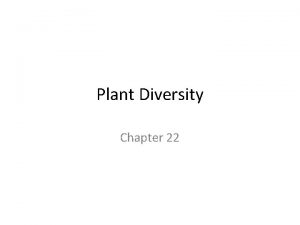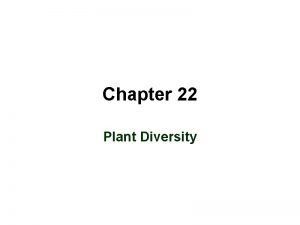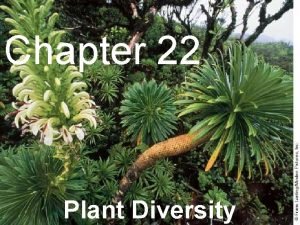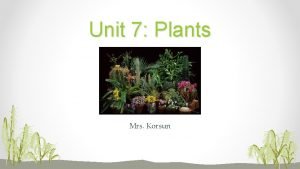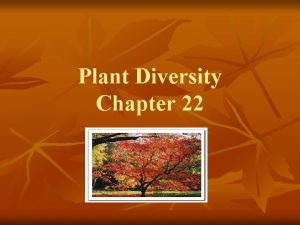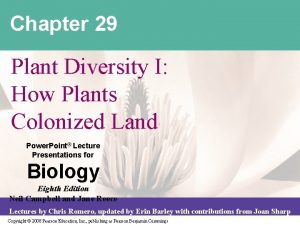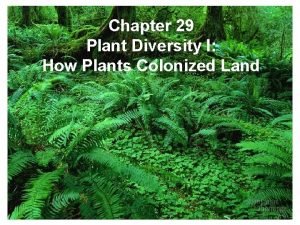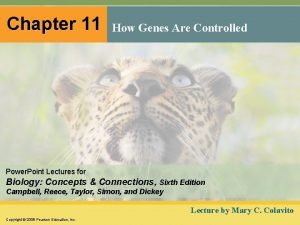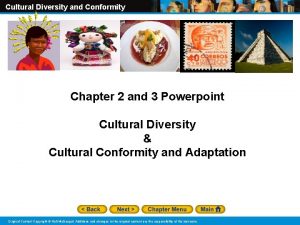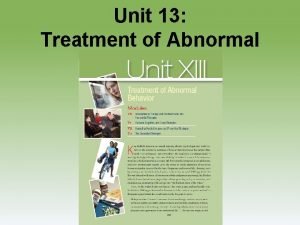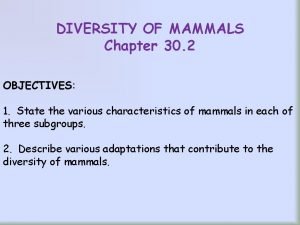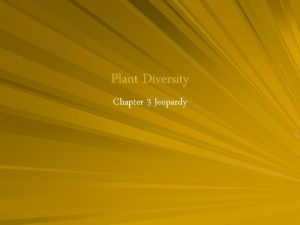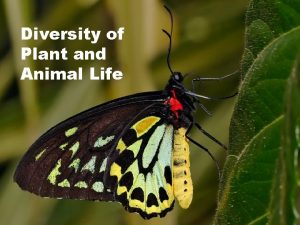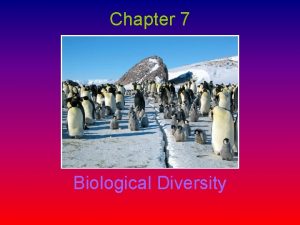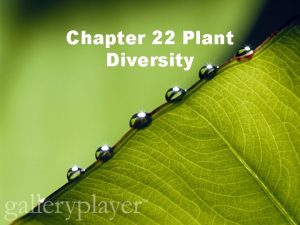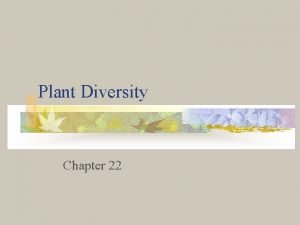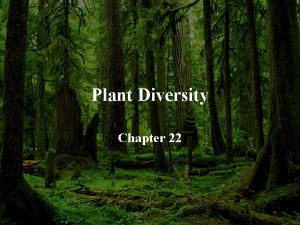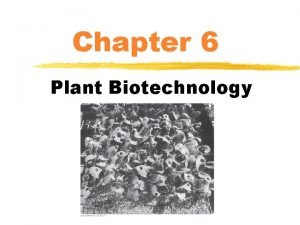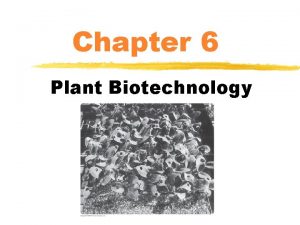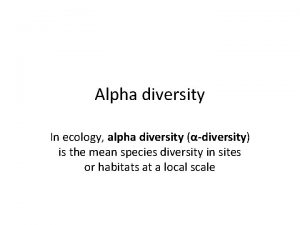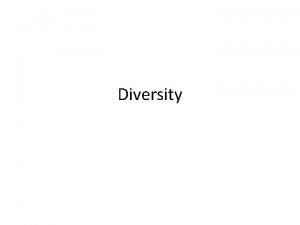Chapter 29 Reading Guide Plant Diversity I How




































- Slides: 36

Chapter 29 Reading Guide Plant Diversity I: How Plants Colonized Land Adapted for Union City High School by Greg Campbell From Campbell, N. and Reece, J. (2008). Biology 8 th Ed. San Francisco, Ca. Pearson Benjamin Cummings.

Overview: The Greening of Earth • • • More than 290, 000 species of plants inhabit the earth today. Although some are aquatic, most are _____: deserts, grasslands, forests Land plants evolved from certain green algae called _______. Copyright © 2008 Pearson Education, Inc. , publishing as Pearson Benjamin Cummings

Concept 29. 1: Land plants evolved from green algae • • Green algae called charophytes are the closest relatives of land plants Land plants share four key traits only with charophytes: 1. 2. 3. 4. _______________________________ Copyright © 2008 Pearson Education, Inc. , publishing as Pearson Benjamin Cummings

• Note that land plants are not descended from modern charophytes, but share a common ancestor with modern charophytes Copyright © 2008 Pearson Education, Inc. , publishing as Pearson Benjamin Cummings

Adaptations Enabling the Move to Land • List 5 benefits to living on land 1. 2. 3. 4. 5. • ____________________ __________ Land presented challenges: a scarcity of water and lack of structural support Copyright © 2008 Pearson Education, Inc. , publishing as Pearson Benjamin Cummings

Fig. 29 -4 Red algae Chlorophytes Plantae Embryophytes Streptophyta Charophytes Viridiplantae ANCESTRAL ALGA

Derived Traits of Plants • Four key traits appear in nearly all land plants but are absent in the charophytes: – ____________(with multicellular, dependent embryos) – Walled spores produced in _______ – Multicellular ________ – ___________ Copyright © 2008 Pearson Education, Inc. , publishing as Pearson Benjamin Cummings

• • Additional derived traits such as a _______and secondary compounds evolved in many plant species Symbiotic associations between fungi and the first land plants may have helped plants without true roots to obtain nutrients Copyright © 2008 Pearson Education, Inc. , publishing as Pearson Benjamin Cummings

Alternation of Generations and Multicellular, Dependent Embryos • • • Plants alternate between two multicellular stages, a reproductive cycle called alternation of generations The ______is haploid and produces haploid gametes by mitosis Fusion of the gametes gives rise to the diploid _______, which produces haploid spores by meiosis Copyright © 2008 Pearson Education, Inc. , publishing as Pearson Benjamin Cummings

• • • The diploid embryo is retained within the tissue of the female gametophyte Nutrients are transferred from parent to embryo through placental transfer cells Land plants are called ______because of the dependency of the embryo on the parent Copyright © 2008 Pearson Education, Inc. , publishing as Pearson Benjamin Cummings

Fig. 29 -5 a Gametophyte (n) Mitosis n n Spore Gamete from another plant Mitosis n n Gamete MEIOSIS FERTILIZATION 2 n Mitosis Sporophyte (2 n) Alternation of generations Zygote

Fig. 29 -5 b 2 µm Embryo Maternal tissue Wall ingrowths 10 µm Placental transfer cell (outlined in blue) Embryo (LM) and placental transfer cell (TEM) of Marchantia (a liverwort)

Walled Spores Produced in Sporangia • • • The sporophyte produces spores in organs called _____ Diploid cells called ______undergo _____to generate haploid spores Spore walls contain sporopollenin, which makes them resistant to harsh environments Copyright © 2008 Pearson Education, Inc. , publishing as Pearson Benjamin Cummings

Fig. 29 -5 c Spores Sporangium Longitudinal section of Sphagnum sporangium (LM) Sporophyte Gametophyte Sporophytes and sporangia of Sphagnum (a moss)

Multicellular Gametangia • • • Gametes are produced within organs called _________ Female gametangia, called _______, produce eggs and are the site of fertilization Male gametangia, called ______, are the site of sperm production and release Copyright © 2008 Pearson Education, Inc. , publishing as Pearson Benjamin Cummings

Apical Meristems • • Plants sustain continual growth in their apical meristems Cells from the apical meristems ______ into various tissues Fig. 29 -5 e Copyright © 2008 Pearson Education, Inc. , publishing as Pearson Benjamin Cummings

• • • Land plants can be informally grouped based on the presence or absence of _____ tissue Most plants have vascular tissue; these constitute the _____plants Nonvascular plants are commonly called ______ Copyright © 2008 Pearson Education, Inc. , publishing as Pearson Benjamin Cummings

• Seedless vascular plants can be divided into clades – Lycophytes (club mosses and their relatives) – Pterophytes (ferns and their relatives) • Seedless vascular plants are paraphyletic, and are of the same level of biological organization, or grade Copyright © 2008 Pearson Education, Inc. , publishing as Pearson Benjamin Cummings

• • A _______is an embryo and nutrients surrounded by a protective coat Seed plants form a clade and can be divided into further clades: – Gymnosperms, the “naked seed” plants, including the conifers – Angiosperms, the flowering plants Copyright © 2008 Pearson Education, Inc. , publishing as Pearson Benjamin Cummings

Concept 29. 2: Mosses and other nonvascular plants have life cycles dominated by gametophytes • Bryophytes are represented today by three phyla of small herbaceous (nonwoody) plants: – Liverworts, phylum Hepatophyta – Hornworts, phylum Anthocerophyta – Mosses, phylum Bryophyta Copyright © 2008 Pearson Education, Inc. , publishing as Pearson Benjamin Cummings

Bryophyte Gametophytes • • In all three bryophyte phyla, ______ are larger and longer-living than _______________are typically present only part of the time Copyright © 2008 Pearson Education, Inc. , publishing as Pearson Benjamin Cummings

Fig. 29 -8 -3 Raindrop Sperm “Bud” Key Haploid (n) Diploid (2 n) Protonemata (n) Antheridia Male gametophyte (n) “Bud” Egg Spores Gametophore Female Archegonia gametophyte (n) Spore dispersal Rhizoid Peristome FERTILIZATION Sporangium MEIOSIS Mature sporophytes Seta Capsule (sporangium) Foot Zygote (2 n) (within archegonium) Embryo 2 mm Archegonium Capsule with peristome (SEM) Young sporophyte (2 n) Female gametophytes

• • • A spore germinates into a gametophyte composed of a protonema and gameteproducing gametophore Rhizoids anchor gametophytes to substrate The height of gametophytes is constrained by lack of _______ Mature gametophytes produce flagellated sperm in _____and an egg in each ______ Sperm swim through ______ to reach and fertilize the egg Copyright © 2008 Pearson Education, Inc. , publishing as Pearson Benjamin Cummings

Bryophyte Sporophytes • • • Bryophyte _____ grow out of _____, and are the smallest and simplest sporophytes of all extant plant groups A sporophyte consists of a foot, a seta (stalk), and a sporangium, also called a capsule, which discharges spores through a peristome Hornwort and moss sporophytes have ______ for gas exchange Copyright © 2008 Pearson Education, Inc. , publishing as Pearson Benjamin Cummings

The Ecological and Economic Importance of Mosses • • Moses are capable of inhabiting diverse and sometimes extreme environments, but are especially common in moist forests and wetlands Some mosses might help retain nitrogen in the soil Copyright © 2008 Pearson Education, Inc. , publishing as Pearson Benjamin Cummings

• • Sphagnum, or “peat moss, ” forms extensive deposits of partially decayed organic material known as peat Sphagnum is an important global reservoir of organic carbon Copyright © 2008 Pearson Education, Inc. , publishing as Pearson Benjamin Cummings

Concept 29. 3: Ferns and other seedless vascular plants were the first plants to grow tall • • • Vascular plants began to diversify during the Devonian and Carboniferous periods Vascular tissue allowed these plants to grow tall Seedless vascular plants have flagellated sperm and are usually restricted to ____ environments Copyright © 2008 Pearson Education, Inc. , publishing as Pearson Benjamin Cummings

Origins and Traits of Vascular Plants • Living vascular plants are characterized by: • Life cycles with dominant ______ • Vascular tissues called ____and ____ • Well-developed _______and _______ Copyright © 2008 Pearson Education, Inc. , publishing as Pearson Benjamin Cummings

Life Cycles with Dominant Sporophytes • • In contrast with bryophytes, ______ of seedless vascular plants are the larger generation, as in the familiar leafy fern The ______ are tiny plants that grow on or below the soil surface Animation: Fern Life Cycle Copyright © 2008 Pearson Education, Inc. , publishing as Pearson Benjamin Cummings

Fig. 29 -13 -3 Key Haploid (n) Diploid (2 n) MEIOSIS Spore dispersal Spore (n) Sporangium Mature sporophyte (2 n) Antheridium Young gametophyte Mature gametophyte (n) Archegonium Egg New sporophyte Zygote (2 n) Sorus Gametophyte Fiddlehead FERTILIZATION Sperm

Transport in Xylem and Phloem • • • Vascular plants have two types of vascular tissue: xylem and phloem ______ conducts most of the water and minerals and includes dead cells called _______consists of living cells and distributes sugars, amino acids, and other organic products Water-conducting cells are strengthened by _______and provide structural support Increased height was an evolutionary advantage Copyright © 2008 Pearson Education, Inc. , publishing as Pearson Benjamin Cummings

Evolution of Roots • • • ______ are organs that anchor vascular plants They enable vascular plants to absorb water and nutrients from the soil Roots may have evolved from subterranean stems Copyright © 2008 Pearson Education, Inc. , publishing as Pearson Benjamin Cummings

Evolution of Leaves • ____are organs that increase the surface area of vascular plants, thereby capturing more solar energy that is used for photosynthesis Copyright © 2008 Pearson Education, Inc. , publishing as Pearson Benjamin Cummings

• • • Most seedless vascular plants are homosporous, producing one type of spore that develops into a bisexual gametophyte All seed plants and some seedless vascular plants are heterosporous Heterosporous species produce megaspores that give rise to female gametophytes, and microspores that give rise to male gametophytes Copyright © 2008 Pearson Education, Inc. , publishing as Pearson Benjamin Cummings

Fig. 29 -UN 3 Homosporous spore production Sporangium on sporophyll Single type of spore Typically a bisexual gametophyte Eggs Sperm Heterosporous spore production Megasporangium on megasporophyll Megaspore Female gametophyte Eggs Microsporangium on microsporophyll Microspore Male gametophyte Sperm

Classification of Seedless Vascular Plants • There are two phyla of seedless vascular plants: – Phylum Lycophyta includes club mosses, spike mosses, and quillworts – Phylum Pterophyta includes ferns, horsetails, and whisk ferns and their relatives Copyright © 2008 Pearson Education, Inc. , publishing as Pearson Benjamin Cummings
 Chapter 22 plant diversity
Chapter 22 plant diversity Chapter 22 plant diversity answer key
Chapter 22 plant diversity answer key Chapter 22 plant diversity answer key
Chapter 22 plant diversity answer key Chapter 20 plant diversity
Chapter 20 plant diversity Plant diversity chapter
Plant diversity chapter Life cycle of seedless plants
Life cycle of seedless plants Microphyll vs megaphyll
Microphyll vs megaphyll Chapter 8 human resources culture and diversity
Chapter 8 human resources culture and diversity Chapter 8 study guide human resources culture and diversity
Chapter 8 study guide human resources culture and diversity Pre reading while reading and post reading activities
Pre reading while reading and post reading activities Genetic diversity vs species diversity
Genetic diversity vs species diversity Genetic diversity vs species diversity
Genetic diversity vs species diversity Tumor suppressor gene
Tumor suppressor gene Cultural diversity and conformity guided reading section 3
Cultural diversity and conformity guided reading section 3 Plant introduction
Plant introduction Plant breeding for disease resistance
Plant breeding for disease resistance Plant introduction in plant breeding
Plant introduction in plant breeding Tronsmo plant pathology and plant diseases download
Tronsmo plant pathology and plant diseases download Tronsmo plant pathology and plant diseases download
Tronsmo plant pathology and plant diseases download Tronsmo plant pathology and plant diseases download
Tronsmo plant pathology and plant diseases download Unit 14 reading guide social psychology
Unit 14 reading guide social psychology Unit 13 treatment of abnormal behavior
Unit 13 treatment of abnormal behavior To what extent has beowulf remained an epic hero
To what extent has beowulf remained an epic hero Marita's bargain reading guide answers
Marita's bargain reading guide answers Guide to college reading
Guide to college reading Guide to college reading
Guide to college reading Reading guide
Reading guide Round robin reading vs popcorn reading
Round robin reading vs popcorn reading Aims of teaching
Aims of teaching Types of readings
Types of readings Reading strategies edb
Reading strategies edb An active process of discovery
An active process of discovery Real definition of extensive reading
Real definition of extensive reading Extensive reading
Extensive reading What is reading
What is reading Chapter 30 section 2 diversity of mammals
Chapter 30 section 2 diversity of mammals Chapter 9 cultural diversity
Chapter 9 cultural diversity
